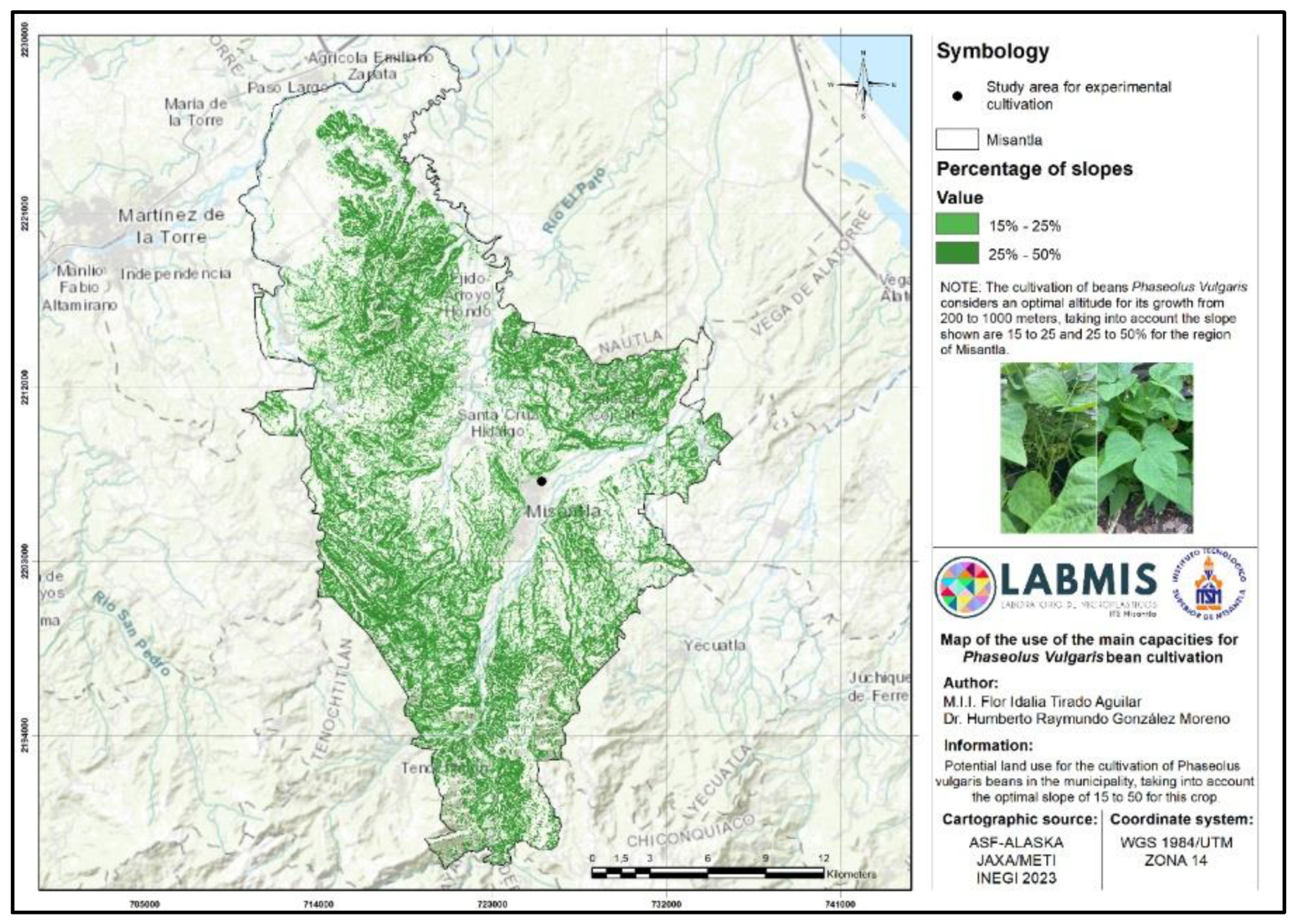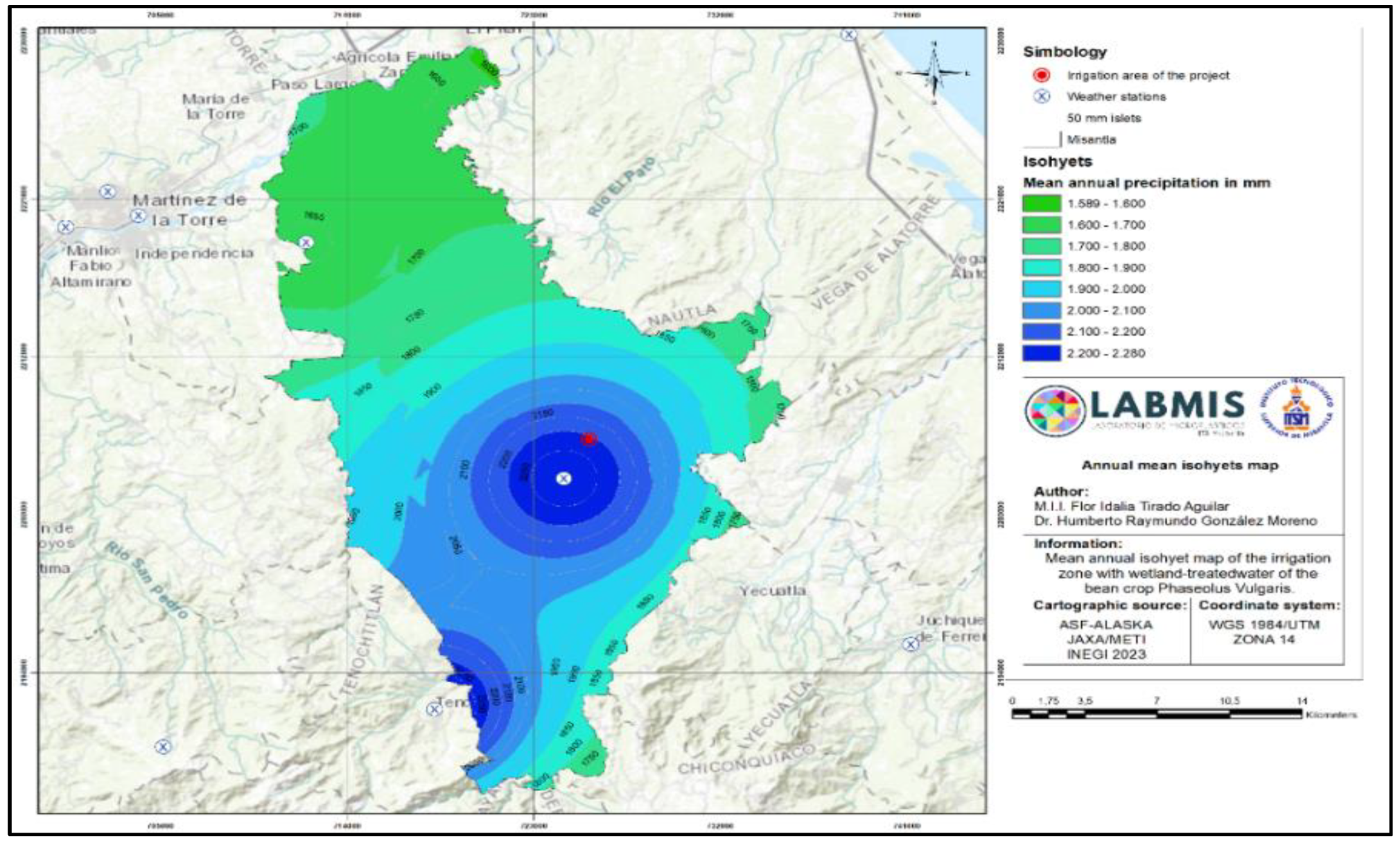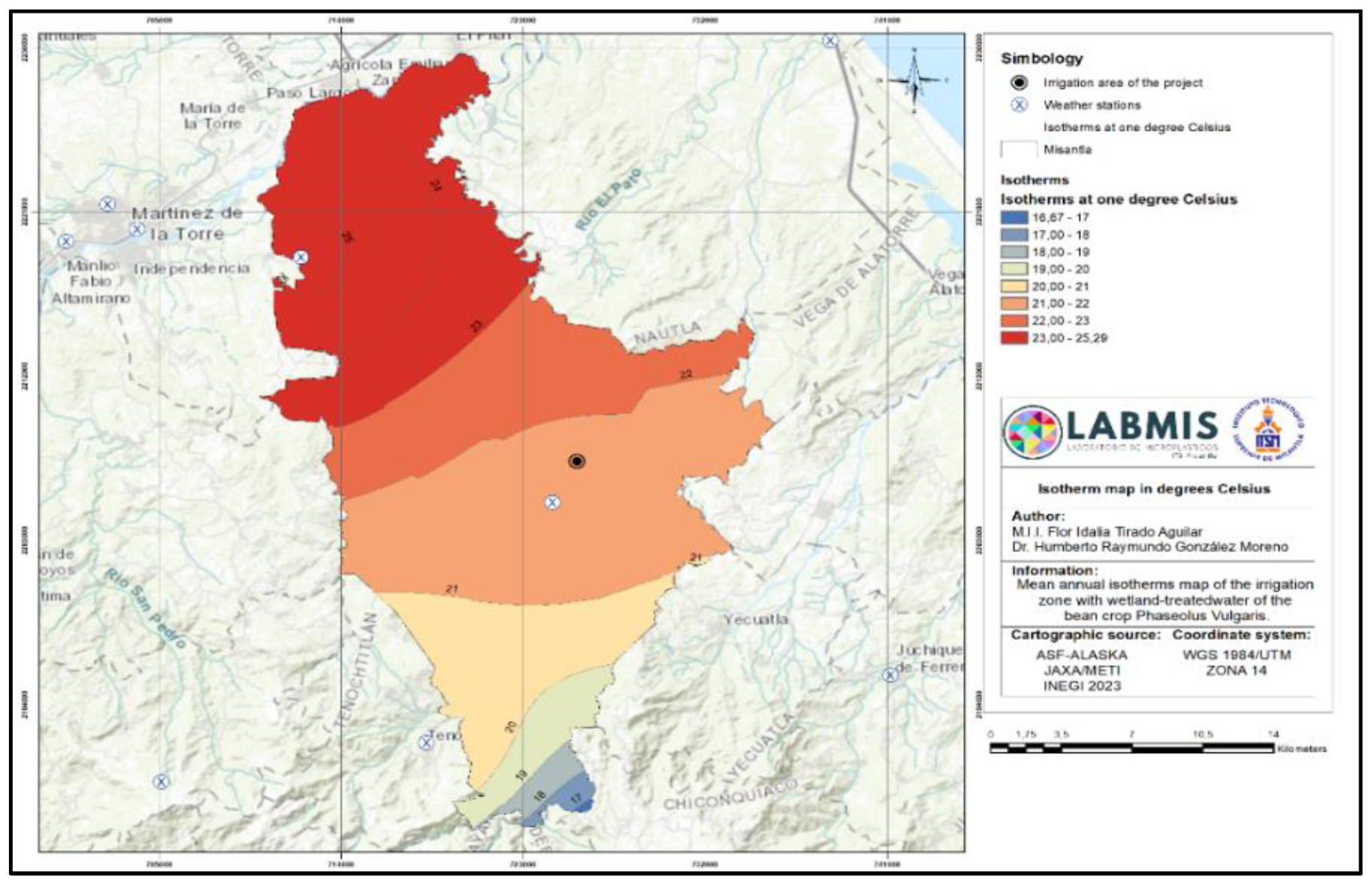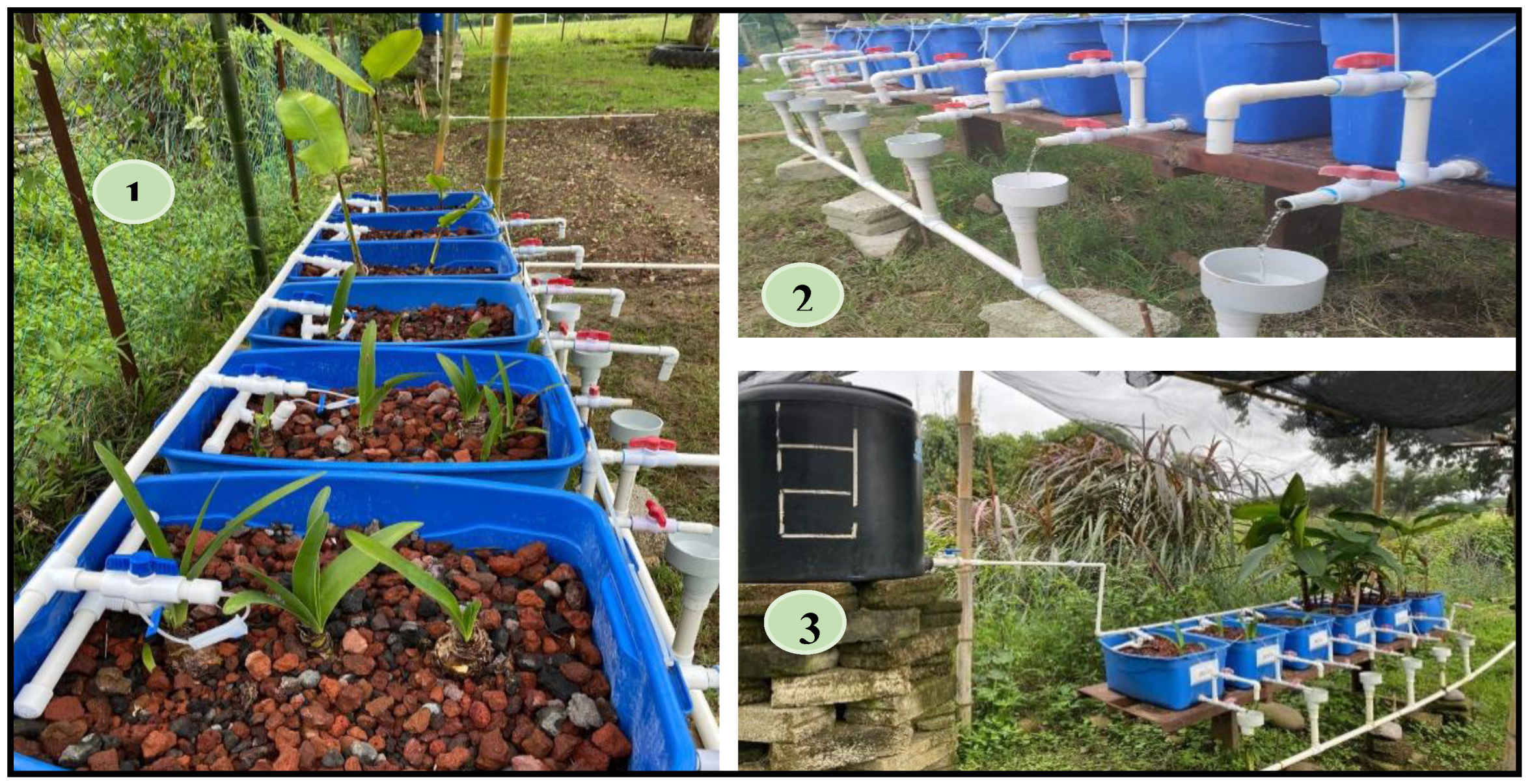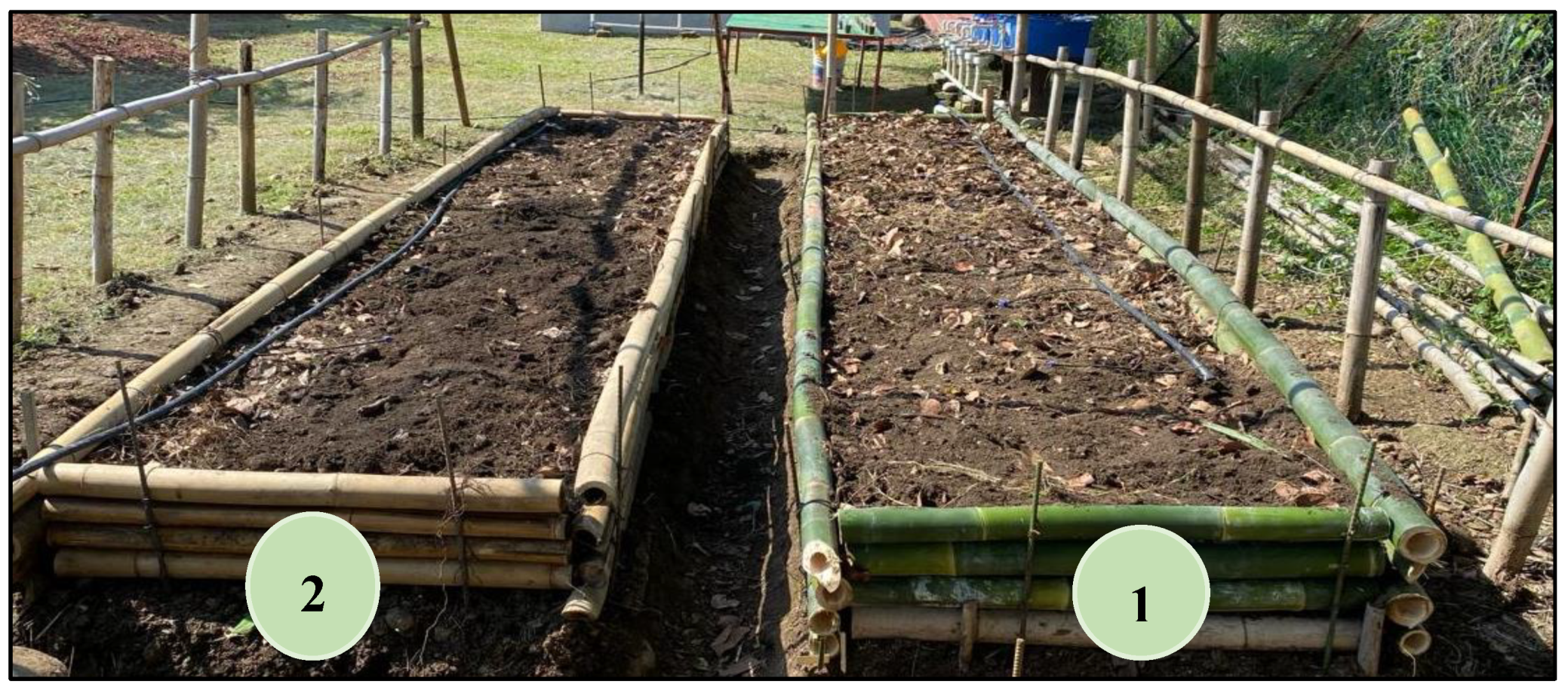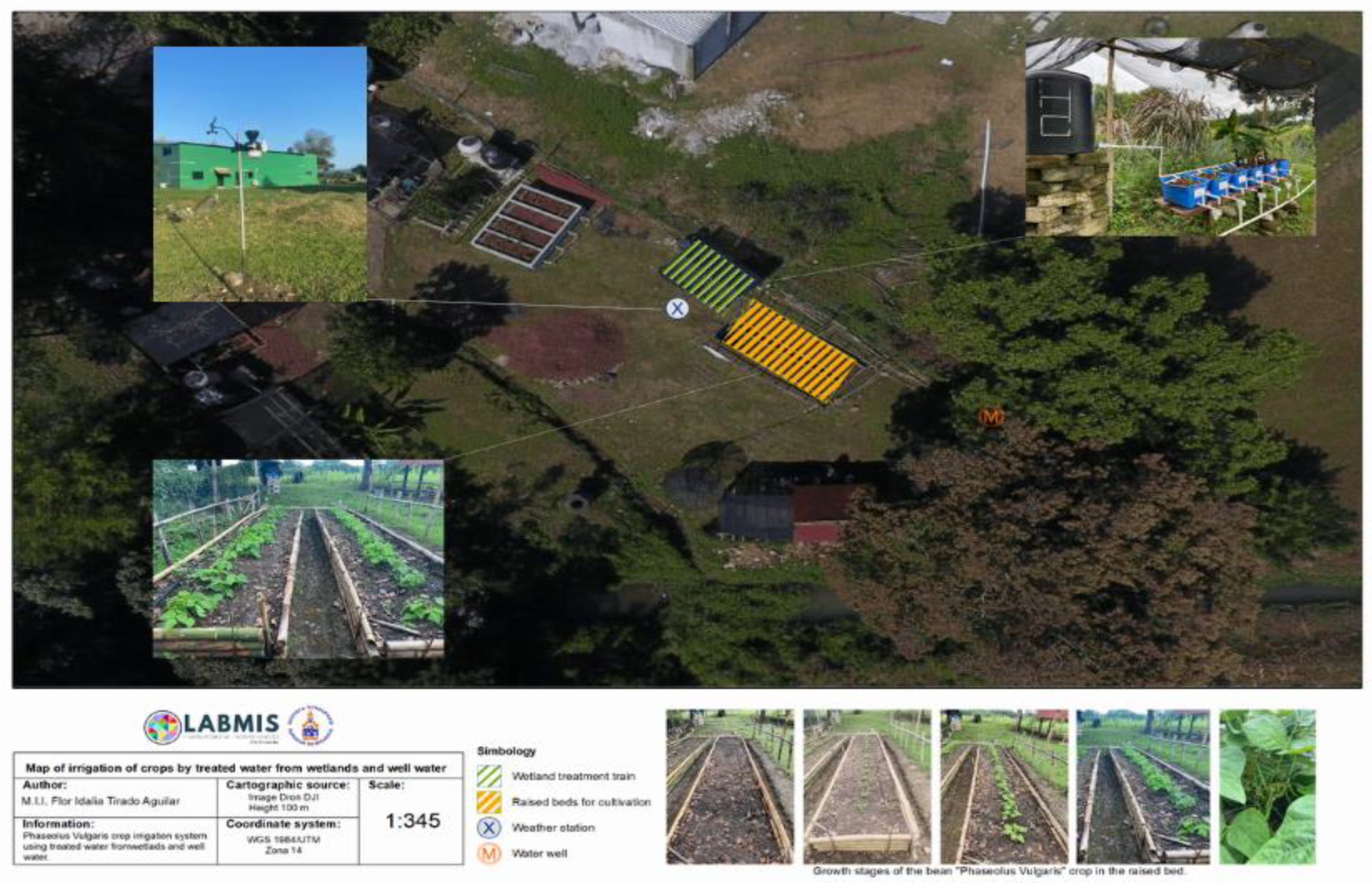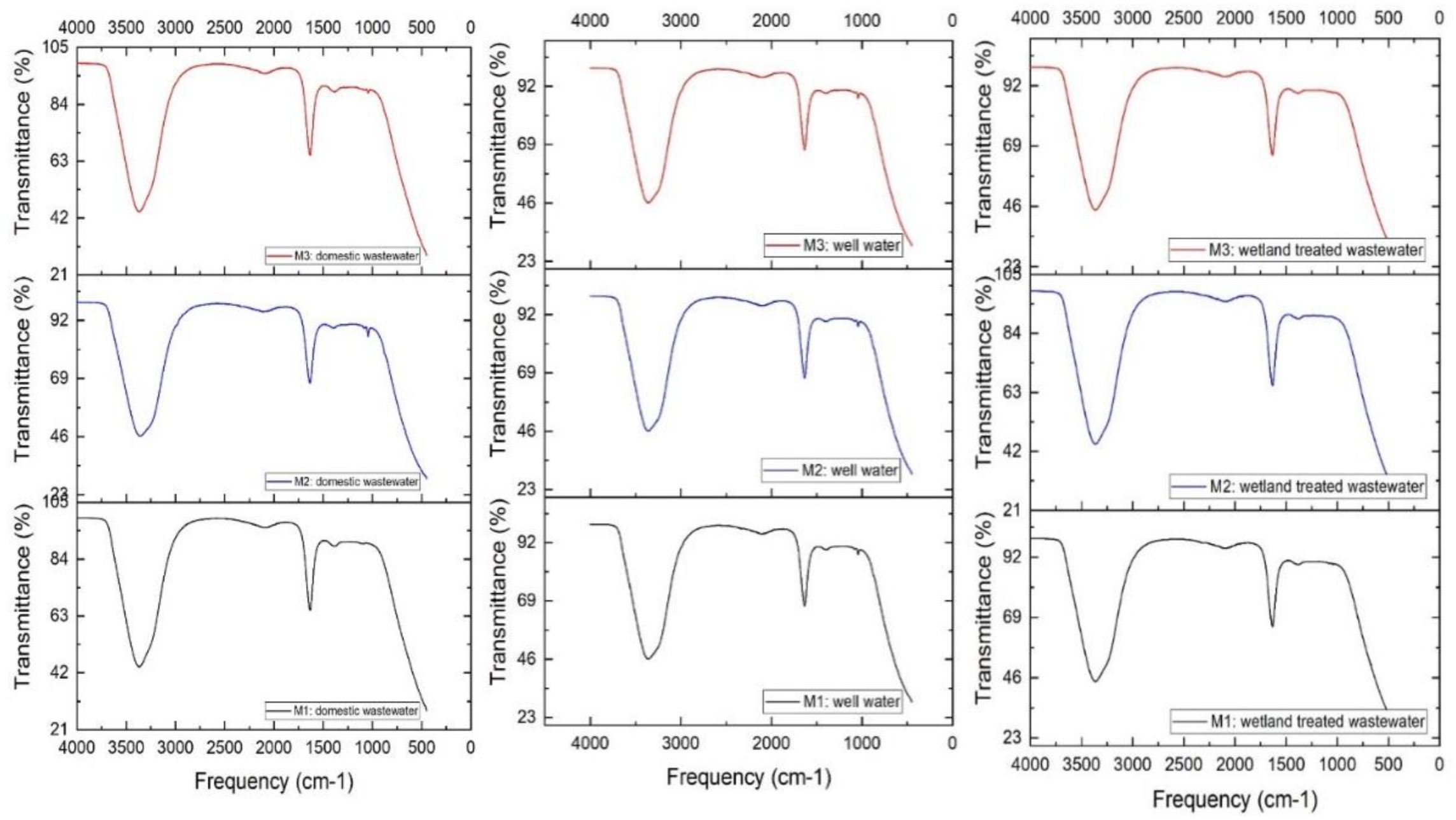1. Introduction
The use of plastic products for all daily activities has caused large quantities in their production and consequently inappropriate and unconscious waste, this has caused them to be found in rivers, lakes, lagoons, estuaries, open-air garbage dumps, streets, drains, fields. and seas, causing their fragmentation and disintegration, thus creating Microplastics (Mp's), reported as a ubiquitous emerging contaminant [
1], harmful, biomagnifying and bioaccumulating[
2], that can cause DNA damage, cellular damage and inflammation in living beings [
3], ), attributing these characteristics to their various forms (films, fibers, fragments and spheres) and compositions (polystyrene (PE), polyethylene (PE), polypropylene (PP), polyethylene terephthalate (PET), polyvinyl chloride (PVC), polyamide (PA) and acrylics) [
4,
5], mostly studied in aquatic fauna[
6], reported to be responsible for affecting the structure of the soil, its porosity and water retention capacity [
7], its presence in the atmosphere and the mobility of said materials through rain [
8], however, the transport of Mp's in soils and groundwater, their migration and destination are still unknown [
9]; These facts have led to taking into account the role played by the food supply chain and questioning the introduction and/or generation of Mp's in it, assuming their presence in agricultural crops as a consequence of the problem of water scarcity and common practices in agriculture.
Essentially, it could be said that the problem of scarcity of available water is derived from the natural conditions in which this resource is distributed, where 97.5% is salt water, and 2.5% of fresh water is distributed between glaciers (69.7%), difficult-to-access groundwater (30%) and 0.3% in rivers and streams, therefore, only 0.007% of the water is available for human consumption (FAO, 2022 ), its extraction by use is for the agricultural sector (69%), industrial sector (19%) and municipal sector (12%) (Virtual Water Center, 2019); Unfortunately, it is appropriate to assume that it is the alliances between first world countries that have been responsible for distributing, monetizing and privatizing most or all of the natural, agricultural and service resources, a situation that mainly harms developing countries (DatosMundial, 2024).
In general, meeting the demands of human needs becomes increasingly difficult [
10], the problems of water scarcity and population increase are the main situations that have led humanity to take radical measures. to quickly meet food security (UN, 2023), including arid and semi-arid regions; Some examples of these measures are the use of low- quality water sources, extraction of groundwater [
11], use of sewage sludge as fertilizer for crop lands [
12], the implementation of technical irrigation systems [
13], ), the use of fertilizers, herbicides, insecticides, pesticides, fungicides, nematicides and pesticides, to prevent, eradicate and/or solve weed, pest and/or diseases, also used for the growth and/or maturation of the fruit and/or enrichment of the land; Unfortunately, it has been recognized that the excess use of these has come to affect the fertility of the land [
14,
15] [
16,
17]. These same agricultural practices consist of using plastic films for insulation and planting coverage, plastic pipes for irrigation systems and plastic covers for greenhouses, which in turn lead to wear and tear of the plastic due to its use and/or due to environmental factors, such as the possible friction between the flow of water and the walls of the pipe and the detachment of plastic from meshes, etc. [
18]; furthermore, simultaneously the practice of irrigating crops, such as vegetables, fruit trees, cereals, legumes, corn and vegetables with untreated wastewater, has become common. Such is the situation in Mexico, where 85% of its crops are irrigated with this type of water [
10].
In addition to this series of situations present in the agricultural sector, the regulations for control and health surveillance of agricultural products are often evaded by the very demands of meeting food demand. Sufficient circumstances to suggest that this entire set of activities and situations are the potential generators of Mp's contamination in agricultural areas [
19,
20]; It is estimated that agricultural soils receive a significant portion (up to 14%) of the total plastic released into the environment [
21], and also that the Mp's released on land is between four and twenty- three times greater than in the ocean [
22]; Even so, this sector has been little studied and the intervention, accommodation, transportation and final destination of the Mp's in agricultural soils is unknown, which over time could reach nearby bodies of water through infiltration and subsurface runoff. or groundwater recharge [
23].
Because of all these situations that trigger problems in our environments, it is the research projects that precisely target some solutions to mitigate them; Therefore, it is appropriate to address that there are eco-technologies that have been recognized as reliable alternatives to mitigate the problem of effluent pollution from domestic wastewater, agricultural waste, industrial waste, runoff and leachate from landfills - Constructed Wetlands (Cws). ); These are highly effective systems in removing contaminants (BOD5 and STD), unlike expensive Wastewater Treatment Plants (WWTP), HC require less economic investment, have low maintenance costs, minimal or zero. energy cost and that is why its construction is being successful in various parts of the world, considering its climate, vegetation and substrate important for its construction [
24].
Constructed Wetlands (Cws) have recently also been mentioned as efficient systems in the retention and/or elimination of Mp's, with an efficiency of up to 98.13% [
25]. And under this premise the objective of this study is raised, identify the presence of microplastics in domestic wastewater, well water and domestic wastewater treated with Constructed Wetlands (Cws) at a mesocosm scale, the latter two used for irrigation of the Phaseolus vulgaris crop through a drip irrigation system. In addition to monitoring the biometric growth of the crop and after harvesting, determining the quality of the fruit for consumption, through safety analysis in Escherichia coli and Salmonella laboratory. Although there are no standardized methodologies for collecting water and sediment samples to identify microplastics, we worked with a harmonized methodology that involves pretreatment with the digestion of organic matter, sedimentation, filtration and subsequently packaging for analysis in Fourier transform infrared spectroscopy (FTIR).
2. Materials and Methods
The research focuses on the objective of identifying Microplastics (Mp's) in three different types of water:
Also, the experiment has been developed with the purpose of reusing the treated water for irrigation of the Phaseolus vulgaris crop, and for comparison purposes, under the same conditions in its construction, two growth beds and a drip irrigation system were adapted. for each of them; However, to carry out the experiment we started from completing six stages, see Diagram 1, and then the description of each of them.
Diagrama 1.
Stages for the development of the experiment. own elaboration, 2023.
Diagrama 1.
Stages for the development of the experiment. own elaboration, 2023.
Stage 1. Crop selection.
Phaseolus vulgaris is one of the most important legumes in the world, it is cultivated in very diverse environments, Central America and the Caribbean are the countries that have the largest areas in production and the highest concentration of population that consumes it (Maqueira et., 2021); Phaseolus vulgaris belongs to the group of legumes that are part of the three food groups of the Plate of Well Eating (NOM-043-SSA2-2005), contributing to human nutrition due to its protein, fiber, vitamin A and calcium content, representing 36% of the daily protein intake, is classified as indispensable in Mexican gastronomic culture (UNAM, 2023) and occupies third place in importance by the area planted in Mexico (FIRA, 2023), it is a crop with a short vegetative cycle ( three months from sowing to harvest), considerations taken into account for their selection; Furthermore, for investigative reasons, when searching for other crops produced in Mexico that could adapt to the conditions of the experimental area, other variables that determine the good development of the crop were taken into account (
Table 1), such as the global coefficient (Kg), the climatic timing for sowing, the requirement for the type of exposure of each crop, distance between strains for sowing seeds, the type of recommended irrigation system and the commercial value (in Mexican pesos); The latter just to consider how accessible or not its acquisition is in the market, the ejotero bean is in fact, an important product in Mexican gastronomy, present in the basic basket of all homes, regardless of the socioeconomic level of the family.
In addition, selecting the crop led to the study of the production of
Phaseolus vulgaris in the Misantla area, see
Figure 1, representing the percentage of the value of the slopes with the presence of production of the
Phaseolus vulgaris crop; The sowing of the crop is distributed throughout the Misantla area, it is adapted to the height and precipitation conditions of the region (analysis based on a high resolution Raster image at 5 meters), the optimal slopes for the aforementioned crop are from the 200 to 1000 meters above sea level and an optimal rainfall of 300 to 400 mm, together it is important to define other characteristics of the area.
Study zone. Misantla is one of the 212 municipalities of the state of Veracruz, Mexico, it is located in the mountainous region of the central zone of the state, at an altitude of 380 meters above sea level, its climate is defined as warm-humid, with an average temperature of 27°C, it occupies an area of 176.6 km2 for agriculture, with a total population of 5,761 inhabitants, with 51.3% women and 48.7% men, the age ranges that center the largest population are from 5 to 19 years in the 2020, which represents an increase in the population of 4.52% compared to 2010 (INEGI 2020). The population increase data indicates an increase in the demand for food, therefore, it has been important to represent the planting capacity of the area for the cultivation of Phaseolus vulgaris.
It has been suggested that Misantla meets the height and precipitation for the good development of the Phaseolus vulgaris crop, however, it must be understood that precipitation is one of the main water resources for the optimal development of crops, allowing the germination of the seeds and the growth of the plants, and when considering the variability of rainfall by area, is how the different timings for carrying out the sowing are determined; For this particular case, the analysis of temperature scales that predominates in the area was carried out (
Figure 2).
Where, through isohyets, the study area can be located with an average annual precipitation of 2200 to 2280mm. Data obtained from the DAVIS 6152 Vantage Pro2 weather station of the Microplastics laboratory of the same institution.
The same situation happens with the temperature, it is important to highlight that, if it is below or above that required by the crop, it will not develop properly, and as a consequence the plant will not carry out its normal biological cycle and therefore will not reach its maximum yield potential in its production and harvest. Therefore, it is also important to determine more specifically the temperatures that fluctuate in the Misantla area; Using the DAVIS 6152 Vantage Pro2 meteorological station, the analysis shows that Misantla has temperature fluctuations between 16 and 25-29° Celsius, however,
Figure 3 shows that in the location of the experimental area the temperature oscillates between 21 and 22° Celsius, a scenario that is beneficial for planting the Phaseolus vulgaris crop. Waiting then for optimal biometric development and harvest performance, taking into account that the experiment is in the open air and not under controllable conditions such as in greenhouses.
Determining the temperature and precipitation that oscillate in the Misantla area has been sustenance to confirm the timing of crop planting (November to February) in 2023.
The water requirement of the crop is the resource that most worries farmers, and the shortage of available water has led them to opt for unreliable alternatives to satisfy that requirement, which is why nature-based alternatives have been put into consideration. have already been reported as efficient in removing contaminants from domestic wastewater, such as Constructed Wetlands (HC), however, the resulting waters have not been used for the irrigation of agricultural crops, which is why the idea of use them in this study at the laboratory level.
Stage 2- Construction of the horizontal subsurface flow wetland system.
Constructed Wetlands (HC) are eco-technologies that have been recognized as reliable alternatives to reduce the problem of effluent pollution from domestic wastewater, agricultural waste, industrial waste, runoff and leachate from landfills, these systems have been reported as effective in removing contaminants (BOD5 and STD), with characteristics that make their construction even more striking, such as the low economic investment requirement, low maintenance cost, minimal or no energy cost and That is why they are having success in various parts of the world, considering their climate, vegetation and substrate important for their construction [
26]. Recently reported as efficient in the removal and/or retention of Microplastics with a rate of 88.63% in Subsurface Flow Constructed Wetlands (SF-CW) [
27]; and with an efficiency of up to 98.13% with Wetlands Built with horizontal flow as a third treatment after having passed through a biological reactor [
25] in addition to this type of Wetlands being the most commonly used [
28], conditioned with plants with ornamental flowers, that key elements in the removal efficiency of common contaminants in domestic wastewater are also reported [
29]. Reasons why, it was considered appropriate to adapt a system of Constructed Subsurface Flow Wetlands conditioned with ornamental plants for the experiment; Two different types, Hippeastrum Hybridum hort and Heliconia bihai marginata, were used because they are native to subtropical and tropical regions, such as Misantla, which makes their access easy if replacement is necessary during the adaptation period (four weeks) or later.
The Wetland system consists of six horizontal subsurface flow cells, in plastic boxes with a volume of 68 liters (measurements: length 41cm, width 59cm, height 41cm), filled with red tezontle substrate (measuring a diameter of 8 mm and with approximately 40% porosity, previously sieved, planted with two different types of ornamental plants Hippeastrum Hybridum hort and Heliconia bihai marginata, fed by a pipe mechanism that connects to a container with a capacity of 100 liters, which is It is kept filled weekly with domestic wastewater, obtained from the drain that passes 15 meters from the experiment area. A 1/2" outlet ball valve was adapted to the container, which controls the flow of domestic wastewater to the Wetlands and is It connects to a 1" hydraulic PVC pipe, which was conditioned with six connections, six stopcocks and six macro-drop solution administration sets, see
Figure 4 section (1) for the supply of waste water to each of the cells, With a horizontal flow in each of them, an outlet was adapted to the boxes, also with stopcocks and hydraulic PVC pipe, as well as goosenecks in each one, with the function of water collection (2), that connect to each other and through this the treated wastewater is collected and directed to one of the Growth Beds (3); Likewise, this wetland system has two groups of three cells, three were conditioned with Hippeastrum hybridum hort and three cells with Heliconia bihai marginata; and from its plantation it must go through the adaptation period (four weeks), where the first week they are fed with 100% well water, the following eight days with 25% domestic wastewater and 75% water from the well, week three with 50% wastewater and 50% well water, for week four with 75% wastewater and 25% well water, and week five with 100% domestic wastewater; This period is essential to ensure that the ornamental plant adapts to its new environment, and it is in this period of time where, if the plant does not survive, it is replaced by one of the same species, however, the monitoring of The ornamental plants in the adaptation period of four weeks demonstrated acceptance to the new conditions of their habitat, without requiring replacements; It is important to mention that, from that period onwards, the Wetlands system is ready to be regulated; the drip flow and the percentage of domestic wastewater to be treated per day is estimated; The Wetlands system was monitored during a period of one year (January - December 2023).
Reuse the treated water by making it reach the growth bed through hydraulic PVC pipe, conditioning a stopcock that connects to the polyduct hose of the drip irrigation system, for the controlled supply of the treated water, taking advantage of the pressure exerted by the force of gravity, has been considered by the distribution of the area assigned for the development of this study.
Stage 3- Construction of growth beds.
The area where the growth beds were built was assigned by the institution and the tools used for their lifting and adaptation were, shovel, pickaxe, bamboo jars and burnt wire, the measurement data were, Growth bed1: 8mtrs length*1.01mtrs width*1.18mts height,
Figure 5 as a visual representation of the growth beds, both with the same measurements and soil conditions for planting the crop Phaseolus vulgaris. With a sandy loam soil, with a pH of 6.88 for growth bed 1 and 7.01 for bed number 2.
Although, the OECD-FAO in its report on agricultural prospects for the period 2023-2032, a demand that, due to continuous advances in plant breeding and a transition towards more intensive production systems driven by the growth and/or expansion of this sector, will represent 79% of the growth in global crop production, with an expansion of arable land of 15% and an intensification of crops of 6%, so it is true that agriculture in the world is a sector that is constantly growing and immersed in technological advances, coupled with the fact that it continues to represent the sector that occupies the highest percentage of available water (70%); It was important to consider an efficient irrigation system in optimizing water distribution widely implemented for agriculture; and based on the specific needs of the area and crop, a drip irrigation system was selected, which guarantees uniformity and greater irrigation coverage [
30], The drip irrigation system is one of the most effective and implemented in the world, because it allows water to be conveyed through a distribution network, conditioned by pipes, throughout the planted surface in small volumes of water on a periodic basis and that also It can be controlled, programmed and regulated [
31]. The irrigation system for the experiment has also been made by comparing efficiencies, reducing water consumption and increasing production, also considering energy consumption and requirements, see
Table 2 and the comparison of irrigation systems that are shown. implemented for different types of crops.
Stage 5- Supply of well water for irrigation.
The experiment consists of two growth beds, both irrigated with a different type of water, as explained, and one of them is irrigated with well water; The well from which water is supplied has the characteristic of being shallow (five meters), and is done by means of a submersible water pump that raises water to make it reach the storage container with a flexible hose, adapted with an outlet that reaches the hose. polyduct of the drip irrigation system, through manual regulation, corresponding to the number of irrigations programmed per day for the crop.
Stage 6- Planting and harvesting the crop.
One of the strategies that SAGARPA recommends to increase the yield and nutritional quality of this particular crop is the search for regions of cultivars with greater adaptation, beyond the different necessary environmental conditions; The analyzes of precipitation and temperature (Map 2 and 3) turned out to be confirmation that the area has the necessary conditions for good crop development, where beans can be a real alternative for producers in the Misanteca region; Therefore, for the experiment, the crop planting process was carried out according to the timing of the crop, and it was during the rainy season (November - February) of 2023. The planting considerations are described in
Table 3.
Experimental design.
To analyze the data generated during the study and compare the removal of contaminants between treatments, a completely randomized experimental design was used.
The data obtained were subjected to a single-factor analysis of variance and to Fisher's LSD mean comparison test (p<0.05). With this method, there is a risk of 5.0% when saying that each pair of means is significantly different, when the real difference is equal to 0, the STATGRAPHICS Centurion XVI software was used. The data were also tested using the non-parametric Kruskal-Wallis test at a 5% significance level. In both cases, the null hypothesis established that there was no difference between the systems planted with Hippeastrum hybridum hort and the systems planted with Heliconia bihaí daisy for the removal of contaminants.
The data on the water requirement for irrigation, soil pH and the type of soil of the Phaseolus vulgaris crop make optimal selection to carry out the experiment, where the experimental area is located within the facilities of the Higher Technological Institute of Misantla, and the indicated points that mark the distribution of the experiment and the real situation of each module can be seen in
Figure 6; The green shaded area is the location of the Constructed Wetlands system, in yellow the location of the Growing Beds, the “x” marks the location of the weather station, “M” in an orange circle marks the storage container from well water; The distribution of the experiment was based on the condition of the size of the growing beds and the selected irrigation system, considering a zero requirement for electrical energy for irrigating the crops.
3. Results
Constructed Wetlands (Cws): During this study over a period of one year (January – December 2023), the average climatic conditions of 26°C, relative humidity of 87% and an average solar radiation of 155 W/m2 were those that provided an adequate adaptive environment for the two types of ornamental plants in the wetland system grew; Hippeastrum Hybridum Hort It reached a height of 35cm and Heliconia Bihai Marginata a height of 90cm. On the other hand, the average light intensity of this study was 1235.24 lux, which is within the intensity ranges of tropical areas (500 to 2,100 lux) [
26].
Remotion of contaminants. It can be seen in
Table 4 that the removal of the pollutants DQO, NT, NH4, NO2-N, PT, PO₄³⁻ and TDS are above 90%, considering the input values (IC), output values (EC) and the removal percentage (Removal (%)). The text continues here.
To determine the validity of the ANOVAS and multiple comparison tests carried out, compliance with the assumptions of the model was verified, in each test the way in which it was verified: Normality, Variance and Independence for each of the parameters, and it was obtained that, for the parameters of DQO, NT, NH4, NO2-N, PT, PO₄³⁻ and TDS, the P-value of the F-test is less than 0.05, there is a statistically significant difference between the means of the 3 variables (Entrada, Hippeastrum hybridum Hort and Heliconia bihaí margarita) with a 95.0% confidence level. To determine which means are significantly different from others, a Fisher's LSD multiple comparisons test was used:
The asterisk (*) found in the p-value column (
Table 4) indicates that these pairs show statistically significant differences with a 95.0% confidence level.
For DQO, NT, NH4, NO2-N, PT, PO₄³⁻ and TDS, significant differences have been identified in the input and output, that is, the Wetlands system removed a significant amount of the considered parameters.
There are no statistically significant differences for the removal DQO, NT, NH4, NO2-N, PT, PO₄³⁻ and TDS between the ornamental plants used.
Kruskal-Wallis test
The Kruskal-Wallis test evaluates the null hypothesis that the medians within each of the 3 variables (Entrada, Hippeastrum hybridum Hort and Heliconia bihaí daisy) are the same.
Since the P-value is less than 0.05, there is a statistically significant difference between the medians at the 95.0% confidence level.
In the case of pH and Electrical Conductivity (EC) of the Wetland system
Since the P-value of the F-test is less than 0.05, there is a statistically significant difference between the means of the 3 variables (Entrada, Hippeastrum hybridum Hort and Heliconia bihaí daisy) with a 95.0% confidence level. To determine which means are significantly different from others, a Fisher's LSD multiple comparisons test was used:
The asterisk (*) found in the column corresponding to the p-value indicates that these pairs show statistically significant differences with a 95.0% confidence level. For pH and EC, significant differences in input and output have been identified, that is, the system reduced a significant amount of pH. There are no statistically significant differences for the pH reduction between the plants used.
Kruskal-Wallis test
The Kruskal-Wallis test evaluates the null hypothesis that the medians within each of the 3 variables (Entrada, Hippeastrum hybridum Hort and Heliconia bihaí daisy) are the same.
Since the P-value is less than 0.05, there is a statistically significant difference between the medians at the 95.0% confidence level.
The planting time of the crop was carried out according to its timing, and it was during a time when rains are frequent (period in which the crop was developed in October 2023 – January 2024), to represent the data of important dates, they are shown in
Table 5. On the other hand, measurements of the pH of the soil of both growth beds were carried out, in a period of 10 weeks (October 17, 2023 – January 12, 2024), the Growth Bed irrigated with treated wastewater obtained a pH of 7.01, and the Growth Bed irrigated with well water a pH of 6.73 on average, measurements taken using a GroLine Soil pH tester pH meter Hanna brand. What both values indicate is that they are within the range indicated by SAGARPA in its national agricultural planning 2017-2030, indicating that the appropriate pH fluctuates between 6.6 and 7.5, because within these limits, most of the soil´s nutritional elements represent their maximum availability. In consideration of the study and as mentioned in the description of the Misantla area, where through the analysis of isotherms and isohyets, it was determined that the experimental area has an average annual precipitation of 2200 to 2280 mm and its temperature ranges between 21 and 22°C, conditions that promoted normal growth of the crop, however, the variable of irrigation with treated wastewater was the one that was worrying in the process of phenological development of the crop.
- 2.
Biometric development of plants.
In the study, a log of the growth in height of the plants was carried out every fifteen days from their germination, taking into account in cm with a metric ruler as a measurement tool, see
Table 6 for the average growth data for each of the plants. crops in both growing beds. Likewise, for both cases, their greatest height was noted in the period of 45 to 60 days, after which the plants began to decline; The harvest time occurred 15 days after the maturity of the pod, to later carry out harvesting work, completely uprooting each plant and subjecting them to a drying time of 10 days under the roof and hanging from a wire, marking each of the plants with their corresponding number, without involving any plastic material.
- 3.
Harvest yield
After drying the fruit, the total product was weighed and shelled. For this process, a high-precision digital scale with a capacity of 1-10kg, BLVEI brand, was used; The area where the weighing and packaging activities were carried out was on a flat wooden base, and as a recommendation for sterilization, latex gloves were used. The beans collected from the pods were placed in ziploc plastic bags for shipment to the laboratory. and subject it to safety analysis. See
Table 7 for total weighing data and number of pods for each of the growing beds
In the summation results in No. of pods per growing bed, Own elaboration, 2023there is a difference of 243 more pods in the growing bed that was irrigated with treated water, and this same one presented 68 grams more in the weighing of the already shelled product; These differences could be due to the properties of the wastewater treated by the wetland system.
Microplastics are an emerging contaminant, of which there is no complete picture, and to date there is no methodology or analytical methods to quantify and/or characterize them in a standardized way, nor a critical comparison, nor validation of them for their measurement, especially for the sampling process; However, in most of the most recent studies for their chemical identification, the Fourier transform infrared spectroscopy (FTIR) technique is used, a vibrational technique, which is defined as suitable for identifying microplastics from the environment, FTIR spectroscopy uses the attenuated total reflection (ATR) technique to explore the region closest to the surface of the sample, analyzing the smallest fraction of Mp's. In the literature it is mentioned that the analytical challenge is the number of organic and inorganic particles that can be in the sample, and that is why they recommend an adequate pretreatment to reduce the organic particles that could overlap with the synthetic particles [
32].
For this particular study, the pretreatment was the same for the three types of water sampled:
1.- Sampling: a glass container with a sterile metal lid with a capacity of 500ml was used.
2.- Digestion of organic matter: based on potassium hydroxide and a thermos stirrer for a period of 24 hours at a temperature of 50°C to achieve the digestion of organic matter in each water sample.
3.- Sedimentation: within a period of 48 hours from the digestion of the organic matter to proceed to packaging in glass test tubes with lids and a capacity of 60 ml, using a glass pipette. Previously marked with a label for identification. Once the samples were obtained, they were sent for analysis in the FTIR equipment, PerkinElmer UATR Two brand, with ATR module.
The results obtained are shown in the form of graphs, see
Figure 7; by groups of three samples respectively to the type of water analyzed.
The interpretation of the ranges was based on those found in the literature, especially taken as reference from those reported by Andrea Käppler in 2016, where when making a comparison of techniques between Raman and FTIR, she exposes the polymers most commonly identified as microplastics;
Table 8 shows the pronounced peaks in the ranges of reported polymers; Despite the fact that a small number of samples were analyzed by the FTIR, this allowed us to redo reported methodologies for taking and processing the samples, in addition to having preliminary results that could be of interest when carrying out more analyzes of other different points of the experiment.
It is known that polymers artificially synthesized in a laboratory have been used in multiple products due to their diverse applications, and are plastic materials derived from petroleum, with different types of monomers and catalysts; The most common polymers identified as microplastics due to their composition and shape are those described in
Table 9, showing their varied applications in their use in different sectors and products.
And consequently, there must be a relationship between the microplastics found in the samples analyzed and the common activities in the locality and/or neighborhood from which the wastewater that is mixed with the wastewater of the institute and that is used for the experiment is evacuated. in the Constructed Wetlands system.
The safety analysis of the Phaseolus vulgaris crop provides a report on the analysis of biological agents or pathogens that could be present in the product; For this study, the GisenaLabs laboratory, Grupo Integral de Services Phytosanitary, ENA SA de CV was requested to analyze the presence of Escherichia coli and Salmonella in the cultivation of the Phaseolus vulgaris variety. The results are shown below:
| RM |
Test |
Unidad |
Result |
Analysis Data |
CA |
| first |
finalize |
| A |
MICROBIOLOGICAL TEST METHODS (SALMONELLA SPP) IN FOOD |
g |
ABSENCE IN 25 |
2024/02/23 |
2024/02/27 |
FSPH |
Reference NOM-210-SSA1-2014 Products and services. Microbiological test method. Determination of indicator microorganisms. Determination of pathogenic microorganisms (Appendix A).
| RM |
Test |
Unidad |
Result |
Analysis Data |
CA |
| first |
finalize |
| A |
MICROBIOLOGICAL (E. COLI) TEST METHOD BY NMP IN FOOD AND WATER. |
NMP/g |
< 3 |
2024/02/23 |
2024/02/25 |
FSPH |
Reference NOM-210-SSA1-2014 Products and services. Microbiological test method. Determination of indicator microorganisms. Determination of pathogenic microorganisms (Appendix H).
NOTAS: NMP: Most Probable Number
In cases where the presence of the microorganism of interest is not detected and according to the sensitivity of the method, it is reported for samples of drinking water for human use and consumption as <1.1 or N.D., in the case of water for recreational use the expression is <1.8 and for solid samples < 3.
- ✓
The analysis indicates that for both tests the Phaseolus vulgaris culture is free of Escherichia coli and Salmonella.
4. Conclusions
According to the samples analyzed, it could be generally concluded that Constructed Wetlands eliminate and/or retain polymers of the following types: PP, PS, PT, PTFE. However, the presence of the polymers PU, EVA, PA, PET, PMMA was still found in the water samples treated by Constructed Wetlands, indicating that there are polymers that travel through the wastewater flow between the tezontle substrate and the roots. of ornamental plants, attributing this transport to the size and composition of the particles, the factor of the type of horizontal subsurface flow of the Wetland system may possibly be involved.
The FTIR results demonstrate the presence of microplastics in well water and domestic wastewater, as had already been reported in other parts of the world [
33], however, for this study, despite the small number of samples analyzed by FTIR, Wetlands can continue to be positioned as efficient ecotechnologies in the removal and/or elimination of Mp's and it continues to seem attractive to analyze the role played by ornamental plants, their roots, and their diversity of adaptation and survival in these environments. ; It is logical to assume with greater validity, the presence of microplastics in the soil that was irrigated with this type of water (well and treated residual), and that, for future analysis, studies are intended to be carried out in sediment (crop soil) and water from the drippers that go directly to the plant, so it would also be interesting to analyze samples of the roots of this crop, however, it has been left available for future research.
With the identification of Mp's in domestic wastewater, domestic wastewater treated with Constructed Wetlands and well water using FTIR microspectroscopy, this study contributes to research that places Constructed Wetlands as efficient ecotechnologies in the removal and/or elimination of Mp's; in turn, the comparison of the average increase in the height of the Phaseolus vulgaris crop and the determination of the quality of the fruit for consumption through safety tests of Escherichia coli and Salmonella, which represents the possibility of generating a sustainable solution in crop production. agricultural crops irrigated with wastewater treated by Constructed Wetlands, however, it is also considered to analyze other crops that provide nutrients necessary for daily life intake; On the other hand, it is convenient to address that, although Constructed Wetlands have been reported efficient as secondary and/or tertiary treatment, this study represents that there is the possibility of being used as primary treatment for the reuse of water for the agricultural sector in order to the results free of Escherichia coli and Salmonella. It would also be necessary to carry out analysis of total and fecal coliforms, for greater safety in consumption and production with this type of water.
Simultaneously, the results of 90% removal of the pollutants COD, SDT, NH4, NT, PO4, NO2 and PT, common in domestic wastewater, support the use of ornamental plants in Constructed Wetlands as key elements in their construction for treatment. of this type of water. In addition to the implementation of a drip irrigation system, it made it possible to satisfy the water needs of the crop in terms of its planting time, which led to good development of the crop in both growth beds. It is also proposed to implement a hydraulic system for irrigating crops through localized drip.


